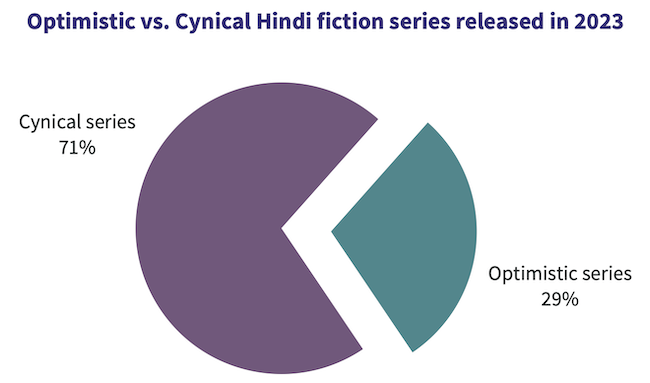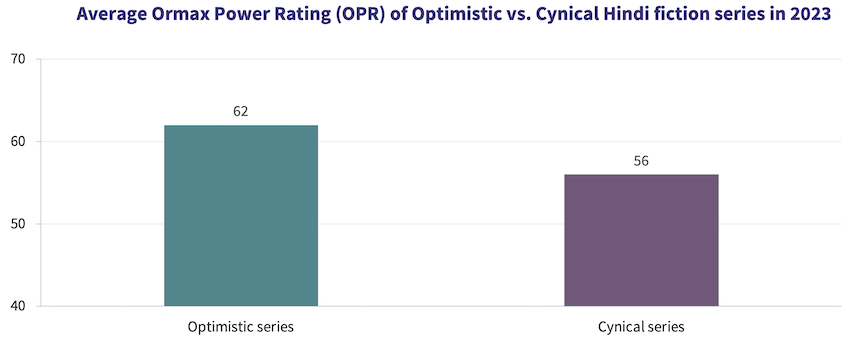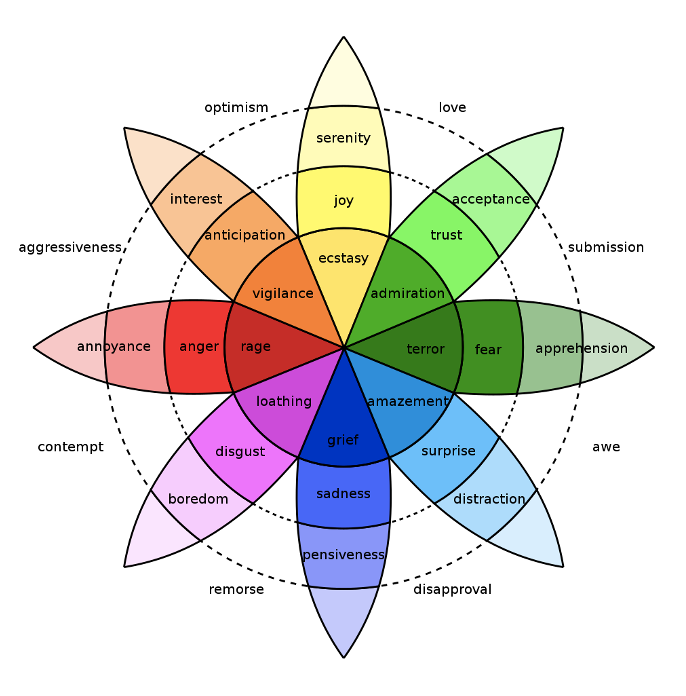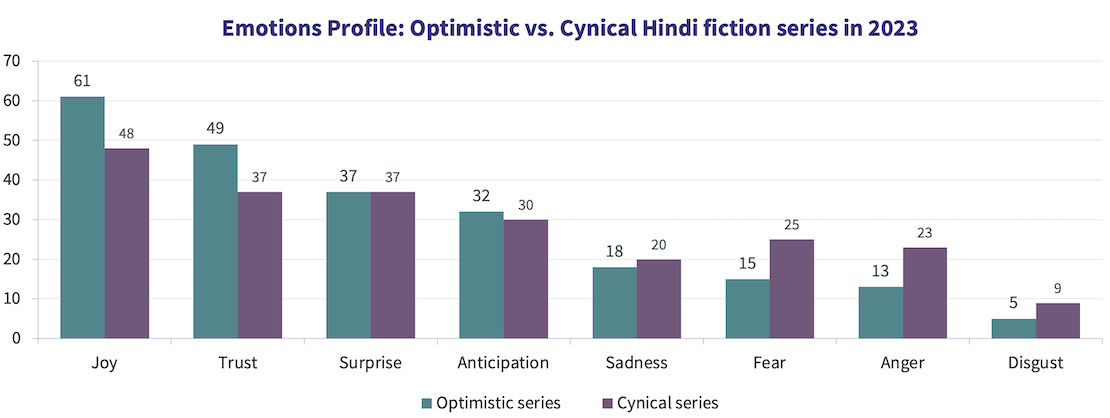


The OTT fiction originals category, especially in Hindi, has witnessed significant growth in the last few years, not only in terms of an expanding audience base, but also in terms of the volume of content available. The nature of content being produced, and the audience tastes and preferences, are both constantly evolving, often shaping, and being shaped by, each other. Diverse stories are being told in multiple genres, providing audience the various benefits that they seek from OTT fiction content.
Across our content testing tools, the benefits that audience seek from content are encapsulated as Ormax Power Rating (OPR) drivers, which are factors that can have a positive influence on a show or film’s audience engagement, once they have decided to watch the content in question. This Sep 2022 product update for Ormax Stream Test has more information on these drivers.
A combination of various benefits leads to Ormax Power Rating (OPR), our proprietary metric to measure audience likeability of all content, ranging from theatrical films to streaming originals to linear television shows. OPR is reported on a 0-100 scale, and can be seen as a representation of the show’s inherent content strength, and is also a surrogate for its advocacy, i.e., % audience who are likely to recommend the content to their friends or family after watching it.
One such benefit that audience seek from OTT fiction content is Optimism. This driver is defined as: Positive tonality delivered through characters, situations and messages present in a show, leading to a promise of feel-good, and an uplifting after-taste.
In a culture where hardships and challenging situations in daily life are the norm for a large section of the audience, it is not surprising that there is a definitive need for positive and uplifting stories. But is this need being sufficiently served by the content that is available currently?
To answer this question, an analysis of Hindi fiction series that released in 2023 was performed, based on their score on the Optimism driver. This score is collected from audiences of each show after the launch of the show. This data is currently available 34 Hindi fiction series launched in 2023. Based on the score, each of these series has been classified either as ‘Optimistic’ (shows that have strong association with the Optimism driver), or ‘Cynical’ (shows that have moderate or weak association with the Optimism driver).

The chart above paints a grim picture (pun intended). Only 29% of the shows analyzed fall in the Optimistic category (e.g., Rocket Boys S2, Taali, Farzi, etc.), with the remaining 71% being classified as Cynical (e.g., Class, Jubilee, Made In Heaven S2, etc.). Interestingly, 50% shows in Optimistic category have a common producer, i.e., TVF. While the genres that TVF operates in (slice-of-life, coming-of-age, youthful, etc.) lend themselves well to positive tonality and treatment, Optimism as a benefit, is by no means restricted to these genres. Optimism is about positive character motivations (e.g., Sandeep Bhaiya), redeeming qualities and uplifting motivations (e.g., Rocket Boys S2), and the strive and ability to change their nature and face difficult circumstances (e.g., Farzi, Taali, etc.). On the flip side, absence of Optimism is to do with self-destructive characters with moral frailties (e.g., Made In Heaven S2), morally-ambiguous actions (e.g., Class), and doomed destinies (e.g., Jubilee). In other words, the benefit is more about positive tonality and approach in characters and story treatment, and the uplifting after-taste the viewer feels as a result.
But is there a difference in audience reception and likeability of these two kinds of shows?

The chart above highlights that the average OPR of shows that are ‘Optimistic’ is 62, whereas for shows that are 'Cynical' is 56, a significant difference of 6 points. This demonstrates that while individual shows in both categories can manage varying levels of success based on their individual quality, on an average, shows with an Optimistic lens about human nature and life are liked more.
Do Optimistic and Cynical shows evoke different emotions among viewers? Plutchik's Wheel of Emotions is a widely recognized and influential model that represents various human emotions and their relationships. The wheel has eight primary emotions: Joy, Trust, Fear, Surprise, Sadness, Disgust, Anger, and Anticipation.
 In our content analysis work, these eight primary emotions are cued to the audience, and for each show or film, they are asked to pick a maximum of three emotions they felt while watching it. This data is used to create the ‘Emotions Profile’ of the show or the film. For the purpose of this analysis, the average Emotions Profile has been created for the two categories of shows: Optimistic and Cynical.
In our content analysis work, these eight primary emotions are cued to the audience, and for each show or film, they are asked to pick a maximum of three emotions they felt while watching it. This data is used to create the ‘Emotions Profile’ of the show or the film. For the purpose of this analysis, the average Emotions Profile has been created for the two categories of shows: Optimistic and Cynical.

Joy and Trust emerge as the top 2 emotions evoked for both kinds of shows. However, the extent of these emotions evoked is significantly different, with Joy and Trust being 13-points and 12-points higher, respectively, for Optimistic shows. In sharp contrast, negative emotions like Anger and Fear are 10-points higher each, among Cynical shows.
In a country where escapism is still a dominant content need, over-reliance on gritty realism and cynical outlook can limit engagement that the audience can have with the category at large. Escapism isn’t just about visual grandeur and innovative premises. In a society where life is bleak and difficult, escapism is also about experiencing positivity vicariously, through the story and characters one consumes. This, however, isn’t an argument for homogenization of content, in terms of its treatment or ideology. But as an evolving category, where new audiences are being inducted into the fold with time, and the medium’s reach increases, a better balance needs to be achieved between the different kind of stories being told.

Introducing Ormax Media Affluence (OMA)
OMA is a new audience classification system designed specifically to measure affluence level of audiences in context of the media & entertainment sector in India

From CTV to Micro Dramas: India's fascinating OTT spectrum
The simultaneous rise of Connected TV and Micro Drama audiences in India over the last year highlights how the Indian OTT market is expanding at both the premium and the mass ends simultaneously

Product update: Content testing for the horror genre
Based on our accumulated audience insights, we are introducing genre-specific drivers for horror films and series in our content testing tools, Ormax Moviescope and Ormax Stream Test
Subscribe to stay updated with our latest insights
We use cookies to improve your experience on this site. To find out more, read our Privacy Policy